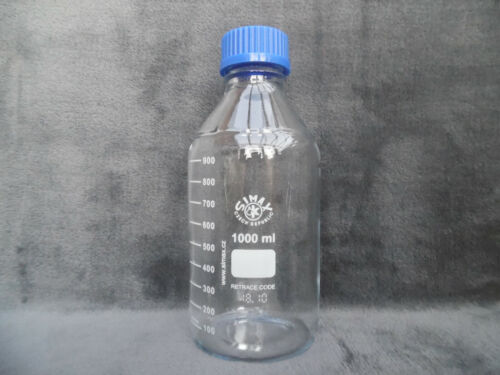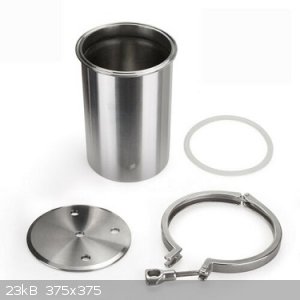Mateo_swe
National Hazard
   
Posts: 556
Registered: 24-8-2019
Location: Within EU
Member Is Offline
|
|
DIY low prerssure reaction vessel
I wonder if anybody here made a DIY reaction vessel that can be used for pressurized reactions?
I mean low pressure reactions like up to say 2,5 to 3 atmospheres where the reaction itself builds up the pressure in the reaction vessel.
There are very roboust hydrothermal reactors with teflon liners you can buy but these are quite expensive and bigger ones very expensive.
And if you also want a pressure gauge they are very expensive.
I would think a DIY low pressure stainless steel reaction vessel could be made if you can weld stainless steel or know somebody that can weld it for
you.
A safety valve would have be installed that is set for releasing the pressure if it climbs over a preset limit.
A pressure gauge would also be nice to monitor current pressure.
Some pressure tests must be made.
I read that the pressure in a sodacan can rise with about 1atm so 2.5 to 3 atm isnt that much pressure.
Anybody hade made such a DIY reaction vessel or something similar?
|
|
|
SWIM
National Hazard
   
Posts: 970
Registered: 3-9-2017
Member Is Offline
|
|
Does it need to be steel?
Champagne bottles and plastic soda bottles will both handle well over 3 atmospheres.
I think Ace and Chemglass threaded glass pressure vessels are rated to like 3 or 4 atmospheres.
Those are usually pretty small (at least the Ace-thread ones I'm familiar with are).

|
|
|
Tsjerk
International Hazard
    
Posts: 3035
Registered: 20-4-2005
Location: Netherlands
Member Is Offline
Mood: Mood
|
|
Champagne bottles hold up to 11 bars, presumably. I did a reaction in a regular 100 ml reagent bottle, nothing special, with a PE liner. The reaction
was 30% HCl, some water and nitromethane, I don't know what the pressure was but the temperature was 100 degrees for 24 hours. I also ran the same
reaction at 110 degrees in an oil bath for a shorter amount of time.
What I also noticed was that 1 liter borosilicate bottles with blue caps (no liners) easily hold the pressure of water at 121 degrees. We had pressure
cooking pans in the lab which were very unsafe and could be opened while hot. Never have I seen borosilicate brake while naive people opened the
cookers while incredibly hot. Unscrewing the bottles ended in geysers, but that is not the point here.
A way to check the breaking point of your vessel is to fill it with water and to heat it to a certain temperature. Just make sure to be out of the way
and to be able to measure the temperature from a distance. If you don't mind the oil from the bath to be against the ceiling you could heat until
breaking. Pressure is almost linear with temperature.
[Edited on 16-5-2022 by Tsjerk]
|
|
|
Mateo_swe
National Hazard
   
Posts: 556
Registered: 24-8-2019
Location: Within EU
Member Is Offline
|
|
When seeing the picture above i just remembered that i have one of those 500ml threaded pressure bottles and its rated for 0.6 MPa (that equals
5.92154 atm).

Here is a link to the pressure flask.
https://www.ebay.com/itm/264055631551?hash=item3d7af12ebf:g:...
The neck is wider in real life than shown in the picture.
This could certainly be used for low pressure reactions.
I wonder if i could add a stainless steel tube down through the threaded PTFE cork that i could connect to a gauge, maybe a safety valve and a needle
valve.
Maybe it would just leak and ruin the pressure flask.
If a bigger reaction vessel is wanted its probably better to make one from stainless steel or use one of them reagent bottles with blue caps
suggested.
How much pressure is developed if one fill one of those 1 Liter borosilicate reagent bottles with blue caps (see pic) with 1L of water and heat it to
121°C?
Does the developed pressure increase or decrease if the bottle is half full vs totally filled with water?
I know these bottles are autoclavable but i didnt know you could close the cap tight with water in them during a sterilization.
These bottles:

But it would sure feel very scary to heat a closed glass bottle without a pressure gauge or safety valve, even it should be ok.
Something inside me just says, no dont do it, its going to blow.
|
|
|
Chemgineer
Hazard to Others
  
Posts: 223
Registered: 25-5-2021
Member Is Offline
|
|
The one in this link is rated to 1.5bar:
https://www.dwk.com/duran-pressure-plus-gl-45-laboratory-bot...
|
|
|
Rainwater
National Hazard
   
Posts: 987
Registered: 22-12-2021
Member Is Offline
Mood: Break'n glass & kick'n a's
|
|
I think the shield you keep the reaction vessel inside of will be more important.
I got a stainless steel pressure cooker modified for assaying rock. Operates at 50psi max. 300c.
It's scary as hell when it's at working temp and pressure. I keep it behind a 3/8 steel plate in case it blows.
"You can't do that" - challenge accepted
|
|
|
SWIM
National Hazard
   
Posts: 970
Registered: 3-9-2017
Member Is Offline
|
|
Yes, a shield.
Ace says their pressure vessels (glass ones with Ace-thread as shown above) should always be used with shielding.
I expect it's a standard practice for everybody else too, as Rainwater says.
I used to do some high pressure vessel stuff, and I used a deep hole in the ground with plywood and sand bags on top as I didn't have good shielding.
That was for a steel vessel heated to around 150C full of ethanolic ammonia and a few other things.
|
|
|
Mateo_swe
National Hazard
   
Posts: 556
Registered: 24-8-2019
Location: Within EU
Member Is Offline
|
|
If its low pressure, up to say 3atm, i think i can do it in the fumehood, it has plexiglass.
Or if done outside a plexiglass shield would be wise to use even the pressure is low.
You never know if the flask/vessel has some hidden flaws that bake it burst even at low pressure.
I would feel better if the flask had a gauge and/or safety valve.
It would also be intresting to know what kind of pressure develops inside the vessel.
I dont think i will do any high pressure stuff, but if it comes up in the future i make sure shielding and safety is more than enough.
|
|
|
Mateo_swe
National Hazard
   
Posts: 556
Registered: 24-8-2019
Location: Within EU
Member Is Offline
|
|
I browsed the net and searched for stainless steel pressure vessels in 1L size.
There are few types used for glue dispensing and the vessels are max rated for 7 to 8bar.
These seem perfect for low and medium pressurized reactions but the prize tag is about 150Euros including shipping from china.
There is one model that has a tri-clamp type lid locking mecanism and another with 3 nuts to tighten the lid.
The tri-clamp type seem very nice and one could attach a gauge instead of the regulator if no external pressure is going to be used.
The glue output port could just be plugged.
These maybe could be used for hydrogenations also.
I dont know if im going to do much pressurized reactions in the future but these SS vessels could probably be used for such things.
   
|
|
|
SWIM
National Hazard
   
Posts: 970
Registered: 3-9-2017
Member Is Offline
|
|
That does look pretty good.
My old pressure vessel has a small plug on top, but with a full sized lid you can inspect the interior and clean it more easily.
I sometimes wonder about internal corrosion with that old thing of mine. I'd be a lot more comfortable using it if I could inspect the inside better.
I really ought to dig that thing out and post a picture. It was a cylinder but went to a sort of sausage shape once when I used it for some really
high pressures.
I figure I was lucky The pressure didn't go higher. It would've been quite a blowup even with it in a meter deep pit with a cover.
|
|
|
macckone
Dispenser of practical lab wisdom
    
Posts: 2171
Registered: 1-3-2013
Location: Over a mile high
Member Is Offline
Mood: Electrical
|
|
paint spray canisters are usually pretty cheap even for big ones.
They are generally rated at 50-60psi.
Harbor freight sells them for $99 for a 2 1/2 gallon.
Put a champagne bottle in this and you are good to go to at least 13 atm and the champagne bottle is shielded by the paint spray canister.
https://www.harborfreight.com/2-1-2-half-gallon-pressure-pai...
do not forget to derate for temperature.
|
|
|
Mateo_swe
National Hazard
   
Posts: 556
Registered: 24-8-2019
Location: Within EU
Member Is Offline
|
|
That paint spray canister looks nice but its quite big.
If you want to preform a reaction at a specific temperature it will be a lot more vessel to heat.
The glue dispensing vessels come in bigger sizes too but the cost goes up.
The small 1L glue dispensing vessels could be placed in a heated oilbath and maybe use magnetic stirring as the vessel is made from stainless steel.
|
|
|
Texium
|
Thread Moved
30-11-2023 at 10:22 |